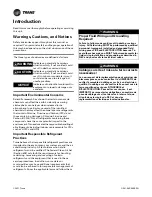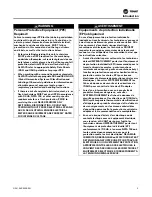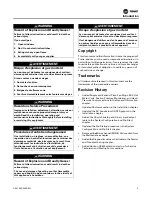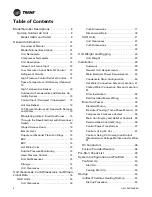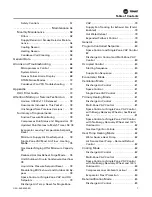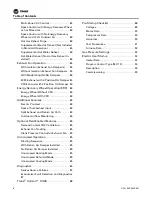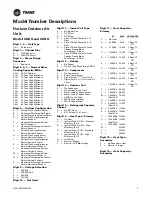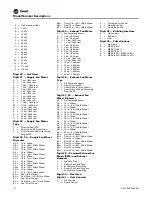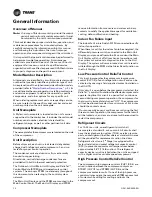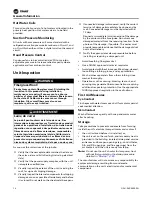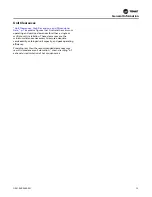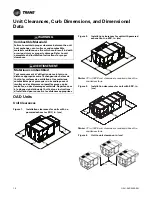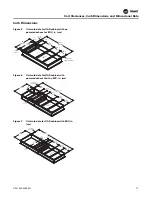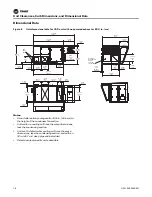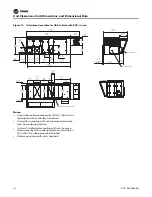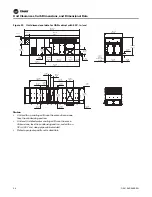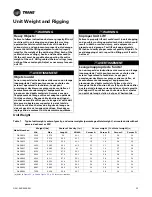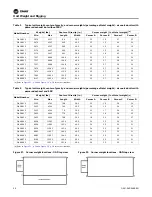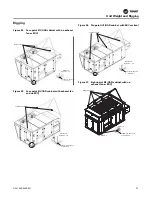
General Information
OAU-SVX006E-EN
13
On dual circuit units, if the high pressure control opens,
the compressor on the affected circuit is locked out. A
manual reset for the affected circuit is required.
Space Temperature / RH Sensor (Optional)
Field installed, wall mounted combination temperature/
humidity sensor (BAYSENS036A) to control space
cooling, heating and dew point.
High Temperature Sensor
The Discharge Air Temperature Sensor (DTC) supplies a
continuous signal to the MCM. Factory setting for
Discharge Air Temperature (DTC) Maximum Discharge Air
Temperature Setpoint (MDTS) is 120°F (range 80–120°F),
the unit will be shut down, and require a manual restart if
Discharge Air Temperature exceeds MDTS for 10 minutes
(adj 10–25 minutes). If DAT exceeds Discharge Air High
Temperature Cutoff (DHCS) of 125°F for 10 minutes for gas
heat and 90°F for electric heat, the unit will shut down and
require manual restart.
Outdoor Air Temperature and Relative
Humidity Sensor
This factory installed combination outdoor air sensor
located in the outdoor air hood is designed to sense both
outdoor air temperature and relative humidity for use by
the microprocessor controller to make required
ventilation, cooling, dehumidification and heating
decisions.
Control Input (Occupied / Unoccupied)
Terminals are provided on the terminal strip labeled
OAUTS for a field installed dry contact or switch closure to
put the unit in the Occupied or Unoccupied modes.
Hot Gas Reheat
This option shall consist of a hot-gas reheat coil located on
the leaving air side of the evaporator.
100 Percent Outdoor Air Hood with
Damper and Filters
Factory-installed and -integrated 100 percent outdoor air
hood with damper controlled by a direct coupled actuator
and 2 in. (50.80 mm) permanent and washable aluminum
mesh filters (mist eliminators) removable through a
hinged access panel. The unit can be factory provided with
an optional 100 percent return air damper controlled by a
direct coupled actuator that is electrically interlocked with
the outdoor air damper.
Modulating Indirect Fired Gas Burner
The unit will have fully modulating, high turndown,
indirect fired gas heat. The heating section will include
high turn-down burners and a stainless steel tubular heat
exchanger. The heat exchanger will be constructed of
type 439 stainless steel and be a tubular design capable of
draining internal condensate. External flue to be
constructed of type 304 stainless steel.
Units will be suitable for use with natural gas or Liquid
Propane (LP) gas.
Through the Base Electrical with
Disconnect Switch
Factory installed 3-pole, molded case disconnect switch
with provisions for through the base electrical
connections will be included. The disconnect switch, with
integral overcurrent circuit breaker, will be installed in the
unit in a water tight enclosure with access through a
hinged door. Factory wiring will be provided from the
switch to the unit high voltage terminal block. The switch
will be UL/CSA agency recognized.
Hinged Access Doors
Hinged access doors with hold open brackets will be
factory-installed.
Electric Heat
The unit may have four stage or fully modulating SCR
controlled electric heat. The primary heating section will
include open coil heating elements, automatic and manual
cut-outs, low voltage controls, air proving switch,
maximum 48 amps per circuit and fusing for heaters over
48 amps. For ductwork installation, refer to
Supply and Exhaust Piezo Fan Rings
Air flow monitoring measuring fan suction and cone
pressure differential to determine fan air flow.
ERV
Energy Recovery Wheels rotate between the incoming
outdoor air stream and the building exhaust air stream. As
the wheel rotates, it transfers a percentage of the heat and
moisture differential from one air stream to the other.
Instead of wasting energy in the exhaust airstream, it is
temporarily captured by the energy transfer media and
then released to preheat, pre-cool, humidify, or dehumdify
the incoming air.
ERV
Energy Recovery Wheels rotate between the incoming
outdoor air stream and the building exhaust air stream. As
the wheel rotates, it transfers a percentage of the heat and
moisture differential from one air stream to the other.
Instead of wasting energy in the exhaust airstream, it is
temporarily captured by the energy transfer media and
then released to preheat, pre-cool, humidify, or dehumdify
the incoming air.


